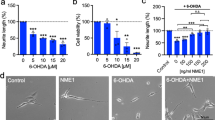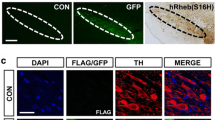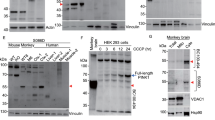Abstract
The etiology of Parkinson’s disease remains unknown. Mutations in PINK1 have provided an understanding of the molecular mechanisms of this pathology. PINK1 and Parkin are important in the dismissal of dysfunctional mitochondria. However, the role of PINK1 in the control of neuronal survival pathways is not clear. To determine the role of PINK1 in the control of the phosphatidyl inositol 3-kinase (PI3K)/Akt pathway mediated by insulin-like grow factor type 1 (IGF-1), we use a model of mesencephalic neurons (CAD cells), which were transfected with lentiviral PINK1 shRNA or control shRNA constructs. Silencing of PINK1 was determined by RT-PCR and immunoblotting; cell viability was analyzed by 3-(4,5-dimethylthiazol-2-yl)-2,5-diphenyltetrazolium bromide (MTT) and lactate dehydrogenase (LDH) assays; proteins of the PI3K/Akt signaling pathway were tested by immunoblotting and IGF-1 receptor, and mitochondria were examined using fluorescence microscopy. PINK1 shRNA-transfected cells showed a reduction in cell survival compared to control shRNA cells. Exposure to IGF-1 induced a rapid and high increase in the phosphorylation level of IGF-1 receptor in control shRNA-transfected cells; however, silencing of PINK1 decreases phosphorylation level of IGF-1 receptor and downstream target proteins such as Akt, GSK3-beta, IRS-1, and hexokinase. Our results further suggest that PINK1 may be regulating the PI3K/Akt neuronal survival pathway through tyrosine kinase receptors such as IGF-1 receptor.





Similar content being viewed by others
Abbreviations
- OSIA:
-
Oxidative-stress-induced apoptosis
References
Akundi RS, Zhi L, Bueler H (2012) PINK1 enhances insulin-like growth factor-1-dependent Akt signaling and protection against apoptosis. Neurobiol Dis 45:469–478
Arboleda G, Waters C, Gibson RM (2005) Metabolic activity: a novel indicator of neuronal survival in the murine dopaminergic cell line CAD. J Mol Neurosci 27:65–77
Arboleda G, Morales LC, Benitez B, Arboleda H (2009) Regulation of ceramide-induced neuronal death: cell metabolism meets neurodegeneration. Brain Res Rev 59:333–346
Arena G, Gelmetti V, Torosantucci L et al (2013) PINK1 protects against cell death induced by mitochondrial depolarization, by phosphorylating Bcl-xL and impairing its pro-apoptotic cleavage. Cell Death Differ 20:920–930
Beilina A, Van Der BM, Ahmad R et al (2005) Mutations in PTEN-induced putative kinase 1 associated with recessive parkinsonism have differential effects on protein stability. ProcNatlAcadSciUS A 102:5703–5708
Betz C, Stracka D, Prescianotto-Baschong C, Frieden M, Demaurex N, Hall MN (2013) Feature Article: mTOR complex 2-Akt signaling at mitochondria-associated endoplasmic reticulum membranes (MAM) regulates mitochondrial physiology. Proc Natl Acad Sci U S A 110:12526–12534
Bondy CA, Cheng CM (2004) Signaling by insulin-like growth factor 1 in brain. Eur J Pharmacol 490:25–31
Brunet A, Datta SR, Greenberg ME (2001) Transcription-dependent and -independent control of neuronal survival by the PI3K-Akt signaling pathway. Curr Opin Neurobiol 11:297–305
Cheng CM, Reinhardt RR, Lee WH, Joncas G, Patel SC, Bondy CA (2000) Insulin-like growth factor 1 regulates developing brain glucose metabolism. Proc Natl Acad Sci U S A 97:10236–10241
Cheng Z, Tseng Y, White MF (2010) Insulin signaling meets mitochondria in metabolism. Trends Endocrinol Metab 21:589–598
Choi I, Kim J, Jeong H-K et al (2013) PINK1 deficiency attenuates astrocyte proliferation through mitochondrial dysfunction, reduced AKT and increased p38 MAPK activation, and downregulation of EGFR. Glia 61:800–812
Dagda RK, Cherra SJ 3rd, Kulich SM, Tandon A, Park D, Chu CT (2009) Loss of PINK1 function promotes mitophagy through effects on oxidative stress and mitochondrial fission. J Biol Chem 284:13843–13855
Dudek H, Datta SR, Franke TF et al (1997) Regulation of neuronal survival by the serine-threonine protein kinase Akt. Science 275:661–665
Durgadoss L, Nidadavolu P, Valli RK et al (2012) Redox modification of Akt mediated by the dopaminergic neurotoxin MPTP, in mouse midbrain, leads to down-regulation of pAkt. FASEB J 26:1473–1483
Froestl W (2000) Receptors in neurodegenerative diseases. Pharm Acta Helv 74:247–251
Geisler S, Holmstrom KM, Skujat D et al (2010) PINK1/Parkin-mediated mitophagy is dependent on VDAC1 and p62/SQSTM1. Nat Cell Biol 12:119–131
Gual P, Le Marchand-Brustel Y, Tanti J-F (2005) Positive and negative regulation of insulin signaling through IRS-1 phosphorylation. Biochimie 87:99–109
Haque ME, Thomas KJ, D’Souza C et al (2008) Cytoplasmic Pink1 activity protects neurons from dopaminergic neurotoxin MPTP. Proc Natl Acad Sci U S A 105:1716–1721
Horton CD, Qi Y, Chikaraishi D, Wang JK (2001) Neurotrophin-3 mediates the autocrine survival of the catecholaminergic CAD CNS neuronal cell line. J Neurochem 76:201–209
Jellinger KA (2002) Recent developments in the pathology of Parkinson’s disease. J Neural Transm Suppl 347–376
Kim SJ, Winter K, Nian C, Tsuneoka M, Koda Y, McIntosh CH (2005) Glucose-dependent insulinotropic polypeptide (GIP) stimulation of pancreatic beta-cell survival is dependent upon phosphatidylinositol 3-kinase (PI3K)/protein kinase B (PKB) signaling, inactivation of the forkhead transcription factor Foxo1, and down-regulation of bax expression. J Biol Chem 280:22297–22307
Liu W, Vives-Bauza C, Acin-Perez R et al (2009) PINK1 defect causes mitochondrial dysfunction, proteasomal deficit and alpha-synuclein aggregation in cell culture models of Parkinson’s disease. PLoS One 4:e4597
Liu S, Sawada T, Lee S et al (2012) Parkinson’s disease-associated kinase PINK1 regulates Miro protein level and axonal transport of mitochondria. PLoS Genet 8:e1002537
Marongiu R, Spencer B, Crews L et al (2009) Mutant Pink1 induces mitochondrial dysfunction in a neuronal cell model of Parkinson’s disease by disturbing calcium flux. J Neurochem 108:1561–1574
Matsuda N, Sato S, Shiba K et al (2010) PINK1 stabilized by mitochondrial depolarization recruits Parkin to damaged mitochondria and activates latent Parkin for mitophagy. J Cell Biol 189:211–221
McCoy MK, Kaganovich A, Rudenko IN, Ding J, Cookson MR (2014) Hexokinase activity is required for recruitment of parkin to depolarized mitochondria. Hum Mol Genet 23:145–156
Murata H, Sakaguchi M, Jin Y et al (2011) A new cytosolic pathway from a Parkinson disease-associated kinase, BRPK/PINK1: activation of AKT via mTORC2. J Biol Chem 286:7182–7189
Narendra D, Tanaka A, Suen DF, Youle RJ (2008) Parkin is recruited selectively to impaired mitochondria and promotes their autophagy. J Cell Biol 183:795–803
Pankratz N, Foroud T (2007) Genetics of Parkinson disease. Genet Med 9:801–811
Pfaffl MW (2001) A new mathematical model for relative quantification in real-time RT-PCR. Nucleic Acids Res 29:e45
Plun-Favreau H, Klupsch K, Moisoi N et al (2007) The mitochondrial protease HtrA2 is regulated by Parkinson’s disease-associated kinase PINK1. Nat Cell Biol 9:1243–1252
Pridgeon JW, Olzmann JA, Chin LS, Li L (2007) PINK1 protects against oxidative stress by phosphorylating mitochondrial chaperone TRAP1. PLoS Biol 5:e172
Sambrook J, Fritsch EF, Maniatis T (2003) Molecular cloning: a laboratory manual, 2nd edn. Cold Spring Harbor Laboratory Press, New York
Sanchez-Mora RM, Arboleda H, Arboleda G (2012) PINK1 overexpression protects against C2-ceramide-induced CAD cell death through the PI3K/AKT pathway. J Mol Neurosci 47:582–594
Sim CH, Gabriel K, Mills RD, Culvenor JG, Cheng H-C (2012) Analysis of the regulatory and catalytic domains of PTEN-induced kinase-1 (PINK1). Hum Mutat 33:1408–1422
Vives-Bauza C, Zhou C, Huang Y et al (2010) PINK1-dependent recruitment of Parkin to mitochondria in mitophagy. Proc Natl Acad Sci U S A 107:378–383
Wang HL, Chou AH, Wu AS et al (2011) PARK6 PINK1 mutants are defective in maintaining mitochondrial membrane potential and inhibiting ROS formation of substantia nigra dopaminergic neurons. Biochim Biophys Acta 1812:674–684
Willaime-Morawek S, Arbez N, Mariani J, Brugg B (2005) IGF-I protects cortical neurons against ceramide-induced apoptosis via activation of the PI-3 K/Akt and ERK pathways; is this protection independent of CREB and Bcl-2? Mol Brain Res 142:97–106
Wood-Kaczmar A, Gandhi S, Yao Z et al (2008) PINK1 is necessary for long term survival and mitochondrial function in human dopaminergic neurons. PLoS One 3:e2455
Wu Z, Sawada T, Shiba K et al (2013) Tricornered/NDR kinase signaling mediates PINK1-directed mitochondrial quality control and tissue maintenance. Genes Dev 27:157–162
Acknowledgments
PINK1 constructs were a kind gift from Dr. Mark Cookson (NIH, USA). CAD cells were a kind gift from Dr. Dona M. Chikaraishi, Department of Neurobiology, Duke University Medical Center, Durham NC, USA. This work was supported by a grant from COLCIENCIAS (110145221189).
Author information
Authors and Affiliations
Corresponding author
Rights and permissions
About this article
Cite this article
Contreras-Zárate, M.J., Niño, A., Rojas, L. et al. Silencing of PINK1 Inhibits Insulin-Like Growth Factor-1-Mediated Receptor Activation and Neuronal Survival. J Mol Neurosci 56, 188–197 (2015). https://doi.org/10.1007/s12031-014-0479-0
Received:
Accepted:
Published:
Issue Date:
DOI: https://doi.org/10.1007/s12031-014-0479-0




